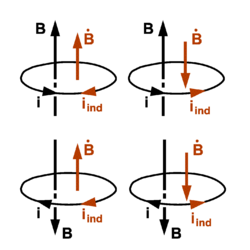Lenz' law: Difference between revisions
Jump to navigation
Jump to search

imported>Paul Wormer (New page: {{subpages}} [[Image:Lenz law.png|right|thumb|250px|{{#ifexist:Template:Lenz law.png/credit|{{Lenz law.png/credit}}<br/>|}}Illustration of Lenz law. The time derivative <math>\scriptstyle ...) |
imported>Paul Wormer No edit summary |
||
| Line 1: | Line 1: | ||
{{subpages}} | {{subpages}} | ||
[[Image:Lenz law.png|right|thumb|250px|{{#ifexist:Template:Lenz law.png/credit|{{Lenz law.png/credit}}<br/>|}}Illustration of Lenz law. The time derivative <math>\scriptstyle \dot\mathbf{{B}}</math> | [[Image:Lenz law.png|right|thumb|250px|{{#ifexist:Template:Lenz law.png/credit|{{Lenz law.png/credit}}<br/>|}}Illustration of Lenz law. The time derivative <math>\scriptstyle \dot\mathbf{{B}}</math> describes an increase of '''B''' (vectors parallel) or a decrease of '''B''' (vectors antiparallel). In the first case the field due to''i''<sub>ind</sub> weakens '''B''' and in the second case it reinforces '''B'''.]] | ||
In [[electromagnetism]] Lenz' law states that a time-dependent change in magnetic induction '''B''' opposes | In [[electromagnetism]] Lenz' law states that a time-dependent change in magnetic induction '''B''' gives an induced current that opposes this change. | ||
According to [[Faraday's law (electromagnetism)| Faraday's law]] the time derivative of '''B''' | According to [[Faraday's law (electromagnetism)| Faraday's law]] of magnetic induction the time derivative of '''B''' | ||
:<math> | :<math> | ||
\dot\mathbf{B} \equiv \frac{d\mathbf{B}}{dt} | \dot\mathbf{B} \equiv \frac{d\mathbf{B}}{dt} | ||
</math> | </math> | ||
induces a current ''i''<sub>ind</sub> | induces a current ''i''<sub>ind</sub> in a conducting loop. The direction of ''i''<sub>ind</sub> is such that the change in field '''B''' is opposed. Recall here that the direction of current ''i'' and field '''B''' are connected through the right-hand screw rule, that is, a screw is driven in the direction of '''B''' and rotated in the direction of ''i''. | ||
The law is named for the Estonian physicist [[Heinrich Friedrich Emil Lenz]] (1804 – 1865). | The law is named for the Estonian physicist [[Heinrich Friedrich Emil Lenz]] (1804 – 1865). | ||
Revision as of 08:51, 15 May 2008
In electromagnetism Lenz' law states that a time-dependent change in magnetic induction B gives an induced current that opposes this change. According to Faraday's law of magnetic induction the time derivative of B
induces a current iind in a conducting loop. The direction of iind is such that the change in field B is opposed. Recall here that the direction of current i and field B are connected through the right-hand screw rule, that is, a screw is driven in the direction of B and rotated in the direction of i.
The law is named for the Estonian physicist Heinrich Friedrich Emil Lenz (1804 – 1865).


